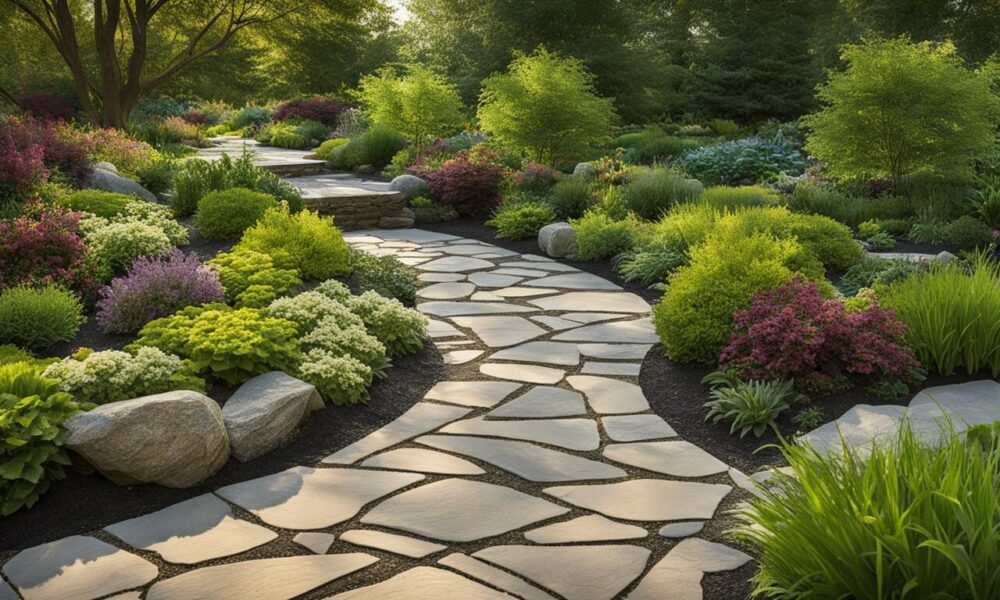Natural Stone Walkway Ideas for Your Garden Path
Adding a natural stone walkway to your garden can enhance its charm and create a beautiful outdoor oasis. There are various options and designs available for creating a natural stone walkway that will complement your home and landscape. By following a few simple steps, you can easily create a stunning walkway that is both functional and aesthetically pleasing.
Key Takeaways:
- Enhance your garden with a natural stone walkway for added charm.
- Choose from a variety of designs to complement your home and landscape.
- Follow simple steps to create a functional and visually appealing walkway.
- Consider the benefits of a natural stone walkway, including curb appeal and protection for your lawn.
- Explore different design ideas and materials for your natural stone walkway to suit your style.
Benefits of a Natural Stone Walkway
A natural stone walkway offers numerous benefits for your outdoor space. Not only does it add curb appeal and enhance the overall appearance of your home, but it also provides functional advantages that make it a worthwhile investment.
One of the key benefits of a natural stone walkway is its ability to direct foot traffic. By creating a designated path, you can guide visitors through your garden or yard, preventing them from trampling on delicate areas or damaging your lawn. This helps to protect your landscaping and maintain its pristine condition for longer periods of time.
Furthermore, a natural stone walkway is highly durable and long-lasting. The sturdy nature of natural stone ensures that your walkway will withstand the test of time, enduring heavy foot traffic without showing signs of wear and tear. This durability makes it an excellent choice for areas that experience high levels of foot traffic, such as the path leading to your front door.
“A natural stone walkway adds a touch of elegance and sophistication to any outdoor space.”
Another advantage of a natural stone walkway is the flexibility it offers in terms of design. With a wide variety of stones, styles, and patterns available, you can create a walkway that perfectly complements your home and reflects your personal style. Whether you prefer a traditional look with uniform rectangular stones or a more eclectic design that incorporates a mix of shapes and colors, the possibilities are endless.
Moreover, the natural beauty of stone adds to the overall aesthetic appeal of your outdoor space. The distinct colors and textures of different types of natural stone create visual interest and can elevate the charm of your garden or yard. The unique characteristics of each stone make your walkway a one-of-a-kind feature that enhances the overall ambiance of your outdoor area.
In addition to its aesthetic and functional benefits, a natural stone walkway also contributes to the promotion of curb appeal. The elegant and inviting nature of a well-designed walkway can significantly enhance the first impression visitors have of your home. Whether you’re planning to sell your property or simply want to create a warm and welcoming atmosphere, a natural stone walkway can greatly improve the overall appearance of your property.
To fully appreciate the benefits of a natural stone walkway, it’s important to choose the right stone for your specific needs and preferences. From flagstone to limestone, each type of stone has its own unique characteristics and attributes. Consider factors such as color, texture, and durability when making your selection to ensure that the stone you choose not only enhances the aesthetic appeal of your walkway but also meets your practical needs.
Explore the Benefits of a Natural Stone Walkway
Installing a natural stone walkway in your outdoor space can bring numerous advantages, from improved curb appeal to protection against wear and tear. Not only does it provide a functional path for foot traffic, but it also adds a touch of elegance and sophistication to your garden or yard. With its durability, versatility in design, and contribution to overall aesthetic appeal, a natural stone walkway is an excellent investment that will enhance your outdoor space for years to come.
Next, let’s explore how you can make your own natural stone walkway through a step-by-step process!
How to Make a Natural Stone Walkway
Building a natural stone walkway is a straightforward process that can be done as a DIY project. By following these instructions, you can create a stunning natural stone walkway that will add both functionality and beauty to your outdoor space.
- Plan out the walkway: Start by marking the desired path of the walkway using stakes or garden hoses. This will give you a clear idea of the size and layout of the walkway.
- Gouge the path: Remove any grass or vegetation from the marked path, ensuring a clean surface for the walkway. Dig the soil to a depth of 4 to 6 inches to create a firm and stable base for the stones.
- Install edging material: Place edging material along the sides of the walkway to provide structural support and keep the stones in place. This will prevent shifting over time and maintain the integrity of the walkway.
- Lay landscape fabric: Before laying the stones, cover the excavated area with landscape fabric. This will help prevent weed growth and maintain the overall appearance of the walkway.
- Add paver sand: Spread a layer of paver sand evenly over the landscape fabric. This will create a level surface for laying the stones and help provide stability.
- Lay the stones: Carefully place the natural stones on top of the paver sand, following the desired pattern or design. Ensure that the stones are level and fit snugly together.
- Fill the gaps: Once all the stones are in place, fill the gaps between them with sand or gravel. This will give the walkway a finished look and help prevent weeds from growing between the stones.
With these simple instructions, you can create a beautiful and durable natural stone walkway that will enhance the aesthetic appeal of your outdoor space.
| Materials | Tools |
|---|---|
| Natural Stones | Garden hoses or stakes |
| Edging material | Shovel or spade |
| Landscape fabric | Wheelbarrow |
| Paver sand | Trowel or hand tamper |
| Sand or gravel | Broom or brush |
Natural Stone Walkway Design Ideas
When it comes to creating a natural stone walkway, the design options are endless. Whether you’re looking for a sleek and modern path or a more rustic and whimsical style, there are creative ideas to suit any backyard. These designs not only add functionality but also elevate the aesthetic appeal of your outdoor space.
If you prefer a simple and straightforward look, consider a gravel stones walkway. This design offers a natural and relaxed feel, perfect for a casual garden setting. The gravel provides texture and allows for easy customization of path width and shape.
“Gravel stones walkways are versatile and can be easily incorporated into any backyard style.” – Landscape Design Expert
For those looking to add a contemporary touch to their garden, a modern and contemporary stepping stone walkway is a fantastic option. Choose sleek and minimalistic pavers with clean lines to create a sophisticated look that complements modern architectural features.
If you desire a more traditional and timeless feel, opt for a simple square-shaped stepping stone walkway. This design is versatile and can be implemented in various garden styles, from formal to cottage-inspired.
To add a touch of nature to your outdoor space, rustic natural stepping stones are a popular choice. These irregularly shaped stones provide a charming and organic look, creating a whimsical pathway through your garden.
If you’re looking for a walkway that adds a sense of exploration and intrigue, consider a winding path. This design uses curved natural stones to create a meandering walkway that leads guests through different parts of your garden, revealing hidden nooks and beautiful surprises along the way.
Customization Options
One of the greatest advantages of natural stone walkways is the ability to customize them to reflect your unique style. By choosing from a variety of shapes, sizes, colors, and patterns of natural stones, you can create a walkway that perfectly complements the overall aesthetic of your backyard.
Visual Inspiration
Take a look at the inspiration below for more creative ideas for natural stone walkways:
| Design | Description |
|---|---|
| Gravel Stones Walkway | A relaxed and versatile design option, suitable for various garden styles. |
| Modern and Contemporary Stepping Stone Walkway | Sleek and minimalistic pavers create a sophisticated and modern look. |
| Simple Square-Shaped Stepping Stones | Timeless and versatile design for a classic garden. |
| Rustic Natural Stepping Stones | Irregularly shaped stones add a charming and organic touch. |
| Winding Pathways | A meandering walkway that adds intrigue and exploration to your garden. |
Classic Brick Walkways as an Alternative
While natural stone walkways can create a stunning garden path, brick walkways offer a classic and timeless look that adds a touch of elegance to any outdoor space. With their rich colors and unique charm, brick walkways are a popular choice for homeowners looking to create a traditional yet inviting atmosphere.
The installation process of a brick walkway is relatively simple, making it an attractive option for those who prefer an easy DIY project. To get started, the surface needs to be leveled and prepared. This involves removing any existing debris and ensuring a firm foundation.
- Level the surface: Begin by clearing the area and ensuring that the ground is level. This can be done by using a shovel and a leveling tool to smooth out any uneven spots.
- Add a barrier fabric: Placing a mesh barrier fabric is essential for preventing weed growth between the bricks. This fabric acts as a barrier while still allowing water to drain through.
- Arrange the bricks: Carefully lay the bricks in the desired pattern, ensuring they are securely placed. You can choose from various patterns such as herringbone, running bond, or basket weave to create a classic or unique look.
- Fill the joints: Once the bricks are in place, fill the joints between them with sand or gravel. This will help stabilize the walkway and prevent shifting over time.
- Finishing touches: Finally, sweep off any excess sand or gravel, and water the bricks to help settle the joints.
Brick walkways not only offer easy installation but also provide durability and low maintenance. Their sturdy nature allows them to withstand heavy foot traffic, making them an ideal choice for paths that lead to entrances or high-traffic areas. Additionally, brick walkways can be easily repaired by replacing individual bricks if necessary.
Benefits of Brick Walkways
A classic brick walkway can transform your outdoor space, offering the following benefits:
- Timeless appeal: Brick walkways have been a staple in architecture for centuries, and their classic look never goes out of style.
- Enhanced curb appeal: The elegance and sophistication of a brick walkway can significantly improve the curb appeal of your home, creating a visually pleasing entrance.
- Versatility in design: Brick walkways can be customized to suit various styles and preferences. With a wide range of colors and patterns available, you can create a walkway that perfectly complements your landscaping.
- Durability: Bricks are known for their strength and longevity, making them a reliable choice for walkways that can withstand the test of time.
- Low maintenance: Brick walkways require minimal upkeep. Regular sweeping and occasional washing are usually sufficient to keep them looking beautiful.

By considering classic brick walkways as an alternative to natural stone, you can achieve a timeless aesthetic that effortlessly blends with your garden. Whether you’re creating a pathway through lush greenery or connecting different areas of your outdoor space, a brick walkway is sure to add character and charm.
Gravel Stepped Paths for a Playful Look
Looking to add visual interest and a playful touch to your garden landscape? Consider gravel stepped paths—a DIY project that can transform the look and feel of your outdoor space. All you need is some pea gravel and wood beams to create a unique and eye-catching path.
First, start by leveling out the grade of your desired path. Use the wood beams to create steps, ensuring they are securely placed. The varying heights and depths of the steps will add visual appeal and dimension to your walkway.
Next, fill in the spaces between the steps with pea gravel. The gravel not only enhances the overall aesthetic appeal but also provides texture and contrast. The combination of the wood and gravel creates a beautiful and natural look that adds charm to your garden.
Gravel stepped paths are not only visually appealing but also easy to maintain. The gravel naturally drains water, preventing pooling and potential damage. Additionally, weeds can be easily pulled from the gravel, ensuring a tidy and well-kept path.
Try different color variations with the pea gravel to suit your personal style and preferences. You can experiment with lighter or darker shades to create a look that truly stands out.
Whether you have a large backyard or a small garden, gravel stepped paths can add character and visual interest. This simple DIY project allows you to personalize your outdoor space and create a walkway that is both functional and visually appealing.
Considerations for Choosing the Right Stone
When it comes to selecting stones for your walkway, it’s important to choose the right type that suits your preferences and requirements. One popular choice for walkways is flagstone, known for its wide and flat shape that creates a visually appealing and natural surface. The selection of stones with a natural surface is crucial for an authentic and rustic look. Stones with a thickness of 2 to 3 inches provide durability, ensuring that your walkway can withstand foot traffic and the elements for years to come.
It is recommended to avoid polished stones for walkways as they can become slippery when wet, posing a potential safety hazard. Instead, opt for stones with a textured surface that offers better traction and grip.
Choosing the right stone for your walkway is not just a matter of aesthetics, but also functionality and safety. Take the time to consider the characteristics of different stones and their suitability for your specific walkway project. By making an informed decision based on your needs and preferences, you can create a walkway that not only enhances the beauty of your outdoor space but also provides a reliable and sturdy path for years to come.

Caption: Flagstone is a popular choice for walkways due to its wide, flat shape. Its natural surface provides a rustic and authentic look, while the thickness of 2 to 3 inches ensures durability.
Tips for Proper Installation and Maintenance
Proper installation and maintenance are crucial for ensuring the longevity and functionality of your natural stone walkway. By following these tips, you can create a beautiful walkway that will withstand the test of time and continue to enhance your outdoor space:
- Accurate planning and measuring: Before starting the installation process, take the time to plan and measure the path where the walkway will be placed. This will ensure that the walkway fits well within your garden and provides a seamless transition between different areas.
- Using the right materials: The success of your walkway installation heavily relies on using the appropriate materials. Choose high-quality stones that are suitable for walkways and consider using a landscape fabric beneath the stones to prevent weed growth.
- Leveling the stones: It’s important to ensure that the stones are properly leveled during installation. This will not only enhance the visual appeal of the walkway but also provide a stable and safe surface to walk on. Use a level tool to check the alignment of the stones as you go.
- Filling the gaps: To create a finished look and prevent weed growth, it’s essential to fill the gaps between the stones properly. Use sand or gravel to fill the gaps, ensuring that it is distributed evenly and securely.
Once your natural stone walkway is installed, regular maintenance is key to keeping it in excellent condition:
- Removing weeds and debris: Regularly inspect your walkway and remove any weeds or debris that may accumulate between the stones. This will help maintain the aesthetic appeal and prevent potential damage.
- Sweeping and washing the stones: Use a broom or a leaf blower to remove dirt, leaves, and other loose particles from the surface of the stones. Additionally, consider washing the stones with a mild detergent and water to remove any stubborn stains.
- Resealing if necessary: Depending on the type of natural stone used, it may be necessary to reseal the walkway periodically. Sealing helps protect the stones from weather elements and preserves their natural beauty. Follow the manufacturer’s recommendations for the appropriate frequency of resealing.
Expert Tip:
Regular maintenance is essential for extending the lifespan of your natural stone walkway. By investing a small amount of time and effort into proper upkeep, you can ensure that your walkway remains beautiful and functional for years to come.
“Proper installation and regular maintenance are the keys to a long-lasting and visually appealing natural stone walkway.” – John Robinson, Landscaping Expert
Enhancing Your Walkway with Plants and Borders
Adding plants and borders around your walkway can greatly enhance its beauty and create a more cohesive look. By incorporating walkway plants and carefully chosen borders, you can create a stunning pathway that seamlessly blends with your garden.
To add color and texture, consider planting flowers or ground cover along the edges of the walkway. Flowers such as roses, hydrangeas, or lavender can provide vibrant pops of color, while low-growing ground covers like creeping thyme or moss add a soft and natural touch. These walkway plants not only add visual interest but also create a sense of harmony between the walkway and the surrounding greenery.
“Incorporating walkway plants adds a sense of natural beauty and charm to your outdoor space.”
In addition to walkway plants, adding borders can help define the path and prevent erosion. Borders such as rocks, bricks, or decorative stones act as a visual barrier, guiding visitors along the walkway while maintaining a neat and organized appearance. They also prevent soil from spilling onto the path and help to retain the walkway materials in place.
When selecting borders, consider the overall aesthetic of your garden and choose materials that complement the surrounding landscape. For a rustic or natural look, weathered rocks or natural stone borders are great options. If you prefer a more polished and formal appearance, neatly arranged bricks or pavers can create a clean and elegant finish.
By thoughtfully landscaping your walkway with well-chosen plants and borders, you can transform a simple path into a captivating feature of your outdoor space.
Benefits of Enhancing Your Walkway with Plants and Borders:
- Adds color, texture, and visual interest to your walkway
- Creates a seamless integration between the walkway and the surrounding garden
- Defines the path, guiding visitors in a visually appealing way
- Prevents erosion and keeps walkway materials in place
- Enhances the overall aesthetics of your outdoor space
| Plant Selection | Border Options |
|---|---|
| Flowers (roses, hydrangeas, lavender) | Rocks |
| Ground covers (creeping thyme, moss) | Bricks |
| Shrubs (boxwood, rosemary) | Decorative stones |
Conclusion
In conclusion, a natural stone walkway is a versatile and stylish addition to any garden or outdoor space. The DIY installation process allows you to create a functional and visually appealing path that perfectly complements your home. By following the steps outlined in this article, you can easily transform your outdoor area into a tranquil oasis.
Whether you choose a natural stone walkway or opt for a classic brick alternative, there are endless design ideas to suit your style. From gravel stone paths to rustic natural stepping stones, you can customize your walkway with different shapes, colors, and patterns of natural stones. The design possibilities are truly limitless.
With the right materials and proper installation techniques, your natural stone walkway or brick walkway will not only enhance the curb appeal of your home but also withstand foot traffic for years to come. Regular maintenance, such as removing weeds and debris and resealing if necessary, will help keep your walkway looking beautiful.
So, unleash your creativity and let your natural stone walkway or brick walkway become the centerpiece of your garden. Start your DIY project today and enjoy the beauty and serenity of your own stunning walkway.



